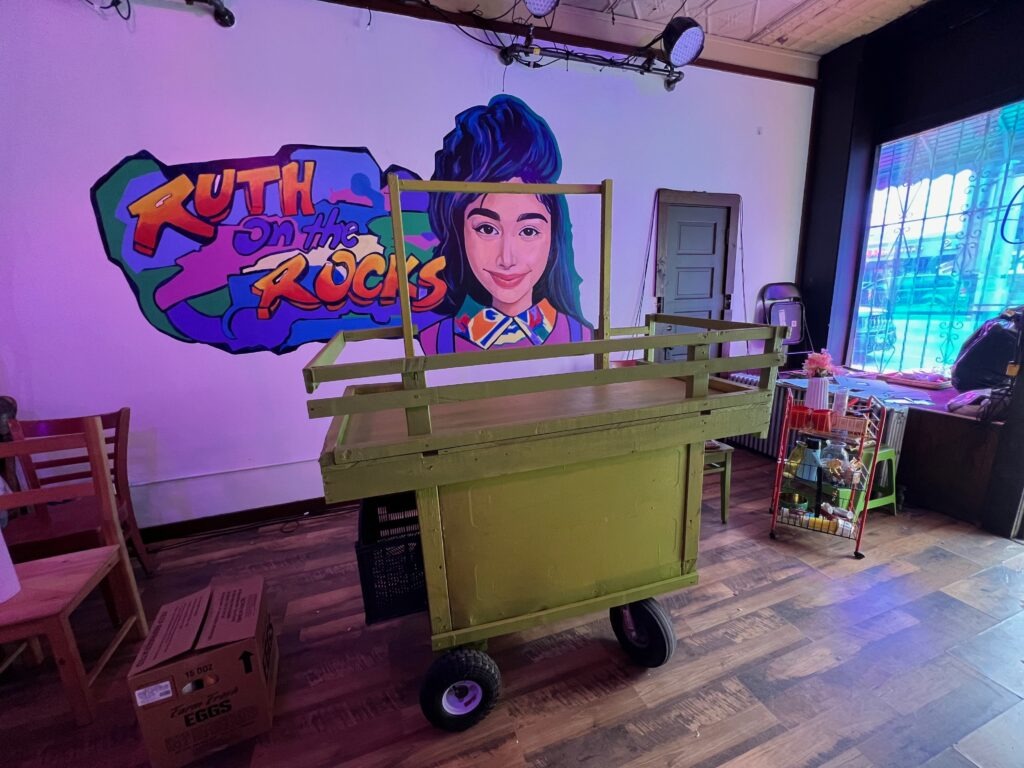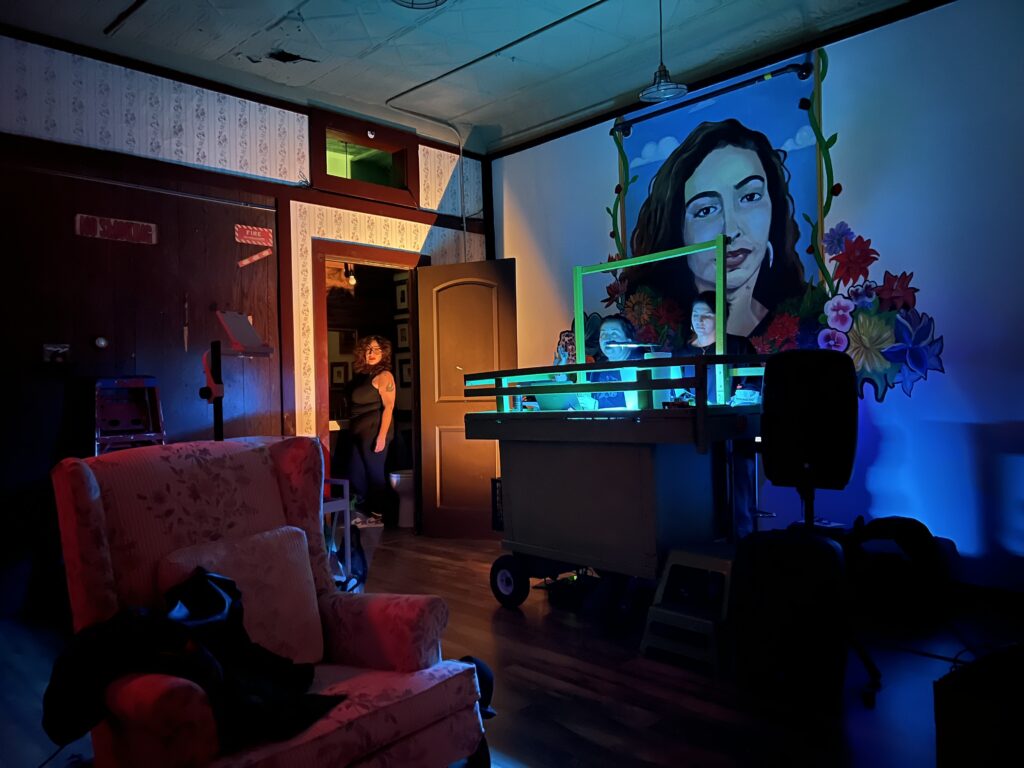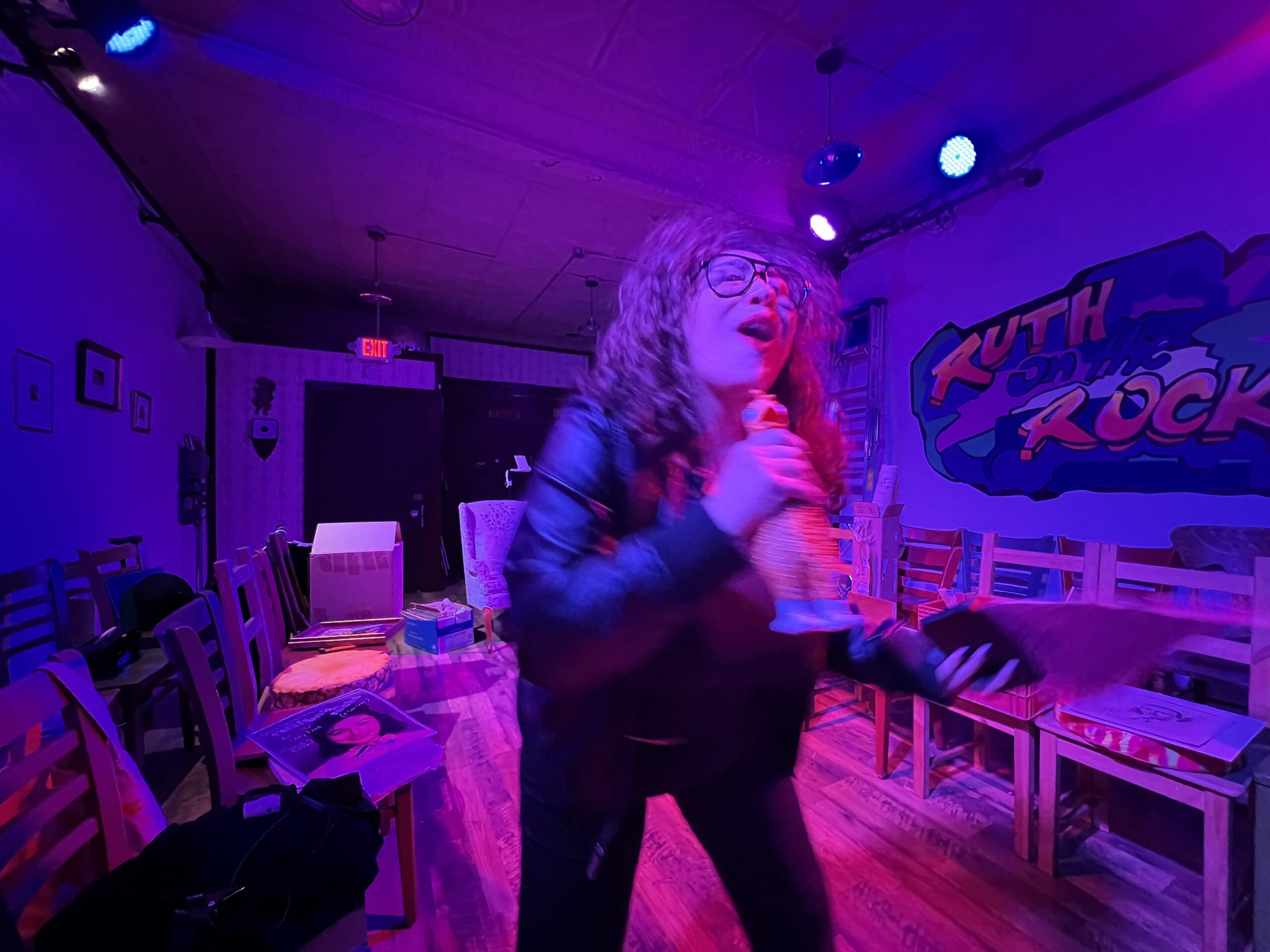One phone call from director Ricardo Gamboa was all it took for Ruth Guerra to be part of Destinos, the seventh Chicago International Latino Theater Festival.
Guerra, a veteran of Chicago’s underground Latino performance scene, is a well of personal stories and local history. Having known her for many years, Gamboa knew from the beginning they would produce an autobiographical show told by Guerra, so Gamboa sent her a series of prompts to home in on the production’s topics: List 10 memories, the good, the bad, the ugly that have irreparably changed your life; what are the names you have been called and what’s the meaning behind them?; what would be the soundtrack of your life?
Guerra’s responses eventually culminated into the mixtape known as Ruth on the Rocks, an immersive, autobiographical solo performance. The play explores the complexities of Latina womanhood — or what the synopsis describes as Guerra’s “hot ass mess of a life.” The show, which runs October 11 through November 16, will be performed in her late father’s repair shop, a staple in Back of the Yards that is still owned by her family and a space emblematic of the Mexican immigrant experience.
Long-time collaborators Gamboa and Guerra say that Ruth on the Rocks invites people to learn more about the Latino art scene that has thrived on the South Side of Chicago for decades in places like Back in the Yards and especially in Pilsen, where between the years of 2008 and 2016 Gamboa and Guerra — self-described Fridas and Diegos — were part of a vibrant arts community before they say gentrification began to consume the neighborhood. The two consider Ruth on the Rocks to be a story that is thoroughly South Side, thoroughly Chicago, and thoroughly Mexican.
I’m curious about the name, Ruth on the Rocks. What is the meaning behind it? I ask this especially because in 2010 you did a reading/performance for Proyecto Latina with the same name — though with a somewhat different topic than this performance.
Guerra: Oh, yeah, that’s how it started! Because I don’t have representation, I said that anything I ever do will be under “Ruth on the Rocks” because I never know which story I’m gonna tell. When people hear “Ruth on the Rocks,” people want to hear the story because — okay, it’s not that I’m outrageous — they have moments of, “Woah. She shared that?” We wanted to keep it because people know it. There’s a web series that I’m writing that’s also called Ruth on the Rocks, so we gotta see where it goes, but if it falls under that one thing, I’d rather just keep it there.
It’s your signature.
Guerra: It’s kind of what made me, honestly. Like we were roaming the streets of Pilsen between the years of 2008 and 2016 acting like these brilliant artists — like the Fridas and the Diegos. That was when the art was thriving — and then gentrification took over.
That’s another thing I love: If anybody is still in Pilsen that was there during that time and they hear “Ruth on the Rocks,” they will come. I’m keeping it. It’s my tag.
According to Ricardo, they’ve been trying to get you to do a solo show for 10 years, so why now?
Guerra: When I tell my stories, it’s always been me. There were a bunch of people pushing to hear more, but it’s definitely been in the works that long. Now it’s a good time because now we have the space, we have the support, and it’s nice to do it here [her father’s storefront], where I feel comfortable. It’s going to give the same authentic feeling as though I’ve invited you to my house.
Gamboa: I think what I love about this play is that it can’t be [neatly] folded. It’s tragic, but it’s also triumphant. A lot of our lives encompass both. We’re valuable, not just because we can offer authenticity. As Latinos from places like where we’re from, we’re also cultural innovators — aesthetic innovators.
That’s very much what we thought about in this show: How do we challenge the solo form?
How do you challenge the solo form?
Gamboa: I think being Mexican and Mexican American is about mixed times, mixed realities, mixed expressions happening at once. That’s very much in this show. One minute you’re in a musical, another you’re playing loteria, or you might be sharing a torta. It’s very immersive and interactive. That’s what we call theater.
Do you usually write autobiographical work?
Guerra: No. [laughs] I’m just always telling stories. But honestly, no. I just thought I was going to be the first Mexican on SNL. That was my goal. But Horatio Sanz beat me to that.
But honestly it was really just in talking and hanging out with friends and sometimes embodying characters. People were like, “Hey remember that story you told us? Can you say it here?” People loved them and wanted to hear more. The nice thing about it is that the majority of them are just of me growing up in Back of the Yards and living here.
Gamboa: Talking to Ruth, you get music history, you get South Side Chicago history, you get neighborhood history. I was like, there’s no way the show cannot be a biographical show because [her] stories become totems, they become monuments for what it means to be Mexican-American and brown and from Chicago.

Ricardo, how is it like directing Ruth, especially after knowing her for 15 years?
Gamboa: So, people have their heroes, and a lot of the time, their artistic heroes are like Frida Kahlo or they’re celebrating the celebrities of the time. My hero is Ruth. That’s one of my artistic icons.
So for me, the only thing I could do is direct with a lot of humility and honor Ruth, honor the stories that [her] body is an archive of, honor this [venue] that is so emblematic of so many Mexican-Americans like her dad who carved a life out of so many insurmountable odds. So I don’t think it’s about what I want, it’s about asking, “What do we as people have yet to be given?”
Guerra: So how do you direct Ruth?
Gamboa: [laughs] A lot of the time, when you look at theater, it’s like the specialization of labor — we kinda threw away with that. All of us are doing double-duty the way a mom or a dad in a Mexican household goes to work and is still the caretaker and nurturer and provider. That mimics itself in the process. I’ve said over and over, I’m your friend before your director. Ruth has approved everything in here.
Why Back of the Yards? What are you hoping the audience will take away from coming to this neighborhood to see your performance?
Guerra: You hear so many negative things about Back in the Yards, but those of us that are here, have been here all of our lives. It’s a strong community. The point is to show a different side of Back in the Yards and what these neighborhoods have to offer, and how we grew up here — and how we’re still here! If it was so bad we wouldn’t be here.
Gamboa: These neighborhoods are repositories of stories and of narratives that never get told. In addition to challenging these dominant narratives of what’s available in this neighborhood, we’re also saying there’s history here, and they deserve to be seen.
Part of it was refusing the idea that neighborhoods like Back in the Yards are like these safety hazards and are void of culture. That’s some colonial shit, right? That people of color can never be credible bearers of culture until it’s recognized from the outside.

The decision to have your autobiographical play in your dad’s repair shop was what captivated me and really drew me in. Can you tell me a bit more about this place?
Guerra: My dad worked his job, but coming home from work, this is where he would repair air conditioners and refrigerators. When he bought the building, he fixed every apartment, we lived in every apartment.
So when he passed, we didn’t want to get rid of the space. I didn’t want to let go of my dad. When Ricky did a play, this was just used as a rehearsal space. When they decided to remodel it and open it up so that we can do some performances here, they were really sensitive about it.
Gamboa: Ruth is being very modest with her kindness and her family’s kindness. Her and her sister rented it to me for $1 a month. I had received a Joyce Award to produce Meet Juan(ito) Doe and remodel this place. We were able to kind of revive it precisely for this production.
How well-known was this storefront to the people in this neighborhood?
Guerra: Embarrassingly well-known. My dad used to drive around in a truck with our phone number, and then he would get mad when boys would call the house.
When my dad passed, I heard so many awesome stories just within the neighborhood — a few from people who I don’t think he even knew. It was always about my dad doing something – helping, fixing. He was always working. But that’s the story of our lives. We all have a side hustle.
I think it’s beautiful that he had so many stories and that you’re continuing that within his own space. In a way his spirit lives on.
Guerra: This is a landmark. A historical landmark to people who’ve been here. Sometimes I’m like, I should be a historian. [Ruth on the Rocks] is a start to that. We’re giving back those stories and letting people hear about how it was to be here.
Is Ruth on the Rocks continuing after Destinos ends?
Guerra: We want to. We’re working with what we can right now, but we definitely want to still work on this — there’s so many stories that have come out of this. This has been so fun; we’re also hoping to put it out there.
Gamboa: Yeah, we thought about touring the show. We think about the communities that are like Back in the Yards and what it would mean to put something like this in the Bronx or Boyle Heights, or even in El Paso. There’s still so many stories that we can continue to tell. Guerra: We have our fingers crossed that we can continue.



